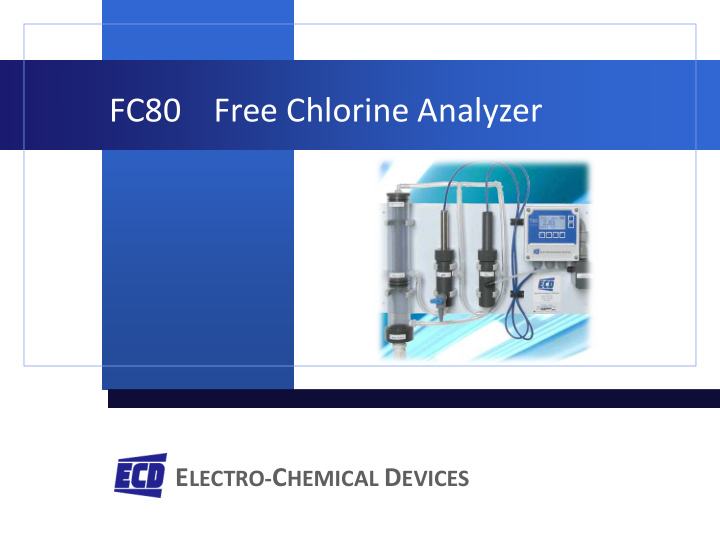



FC80 Free Chlorine Analyzer E LECTRO- C HEMICAL D EVICES
FC80 System Configuration Free Chlorine Analyzer 1) Constant Head Flow Controller 2) S80- pH with Temperature Sensor 3) Free Chlorine Sensor (FCS) 4) T80- Analyzer and Controller 5) Optional Spray Cleaner
What is Free Chlorine? Free Chlorine is the sum of the Hypochlorous acid and Hypochlorite ion in the sample. Chlorine gas (Cl 2 ) dissolves in water as Hypochlorous acid (HOCl) and Hydrochloric Acid. Cl 2 + H 2 O > HOCl + OCl - + H + + Cl - Bleach dissolves in water to form Sodium Hypochlorite and Sodium Hydroxide. NaOCl + H 2 0 > HOCl + OCl - + OH - + Na +
What is Free Chlorine? Free Residual Chlorine is the measured value, The amount available to do work. Residual = Dose – Demand It is the chlorine in the sample that is available to measure. The FC80 doesn’t measure Total Residual Chlorine . Total = Free + Combined Combined Chlorine is chlorine bound to an organic molecule Ammonia products being the most common, Chloramines. Total Chlorine requires a reagent based wet chemistry technique or a special amperometric sensor. Use The TC80
Free Chlorine Sensor FC80 Intelligent Free Chlorine Sensor Stores Calibration Digital Communication Polarographic Design Polarization and measurement circuitry inside the FC80 sensor Gold Cathode Silver-Silver chloride Anode Replaceable rugged Teflon Membrane Refillable Potassium Chloride Electrolyte PVC outer body
How does it Work? A fixed voltage is applied between the Anode and Cathode. At Start Up, the polarization voltage consumes any oxidizable materials in the sensor. The current decreases with time as the sensor stabilizes at the “zero point current.” The initial polarization takes about 60 minutes. The Chlorine sensor is now ready to use.
How Does it Work? (cont’d) The Teflon membrane allows only neutrally charged molecules to pass through HOCl is a neutral molecule and will pass through the membrane. OCl¯ is charged and won’t pass. Salts are charged and won’t pass. Hypochlorous acid, HOCl, diffuses through the membrane and is reduced (gains electrons) at the cathode to form chloride. Silver is oxidized (gives up electrons) at the anode which precipitates the chloride, as silver chloride, completing the current loop. HOCl is directly measured by the sensor and OCl¯ is inferred from the pH.
Measurement Influences pH Sensitivity The ratio HOCl/OCl is pH % HOCl % OCl dependent. HOCl ↔ H + + OCl - Where the pH of a solution 100 100 90 90 = pKa of a chemical, the ratio of acid to base 80 80 species is 1:1 70 70 60 60 pK a (hypochlorous acid)= 7.5 % HOCl % OCl HOCl = OCl - @ 7.5 pH 50 50 By Measuring the pH, the 40 40 30 30 T80 Transmitter can 20 20 determine the percentage 10 10 of free chlorine that is being 0 0 measured and calculate the 4 6 8 10 12 pH Units total Free Chlorine present.
pH Measurement Flange mounted S80 pH Sensor Measures pH and temperature Intelligent Sensor stores calibration information Digital communication Easily replaceable pH electrode cartridge Convenient sample port
Measurement Influences FCA Temperature Temperature Sensitivity Dependence, 4%/C° Output increases with temperature, 4% per C° 50 40 Output decreases with cooling 30 mV/ppm Cl 2 Primarily due to the change in the 20 permeability of the membrane with 10 temperature 0 0 20 40 60 Temperature C° Flow Sensitivity FCA Flow dependence The FC80 sensor consumes chlorine 100 Flow replenishes the chlorine 80 % supply 60 Theoretical output Flows above 10 gal/hour are flow 40 independent 20 0 Low flow = Low reading 0 10 20 30 Constant flow = Stable reading Flow rate, gal/hr
Constant Head Flow Controller The CH Flow Controller eliminates the need for Pressure Regulators and Rotameters that would be needed to keep the flow constant. The unique overflow design maintains a constant flow at the sensor with incoming variations between 8 and 80 gal/hr.
Where is it used? Chlorination of Municipal drinking water Cooling Towers Industrial disinfection of rinse waters Food processing o Pasteurization lines o Bleaching Processes Oxidation in Chemical processing Mining o Sulfide removal o
Start up Guide Mount FCA Panel securely Verify the Calibration of to a wall or rail system. the S80 pH sensor. Supply power to the T80 Verify the Chlorine reading Transmitter as shown in the with a DPD test. “Wiring Instructions”. IT’S DONE !!! Install the FCS and S80 pH Check Calibration monthly sensors into the flow cells. (The pH is closest to the CHFC tube). Connect sample line to the ¼” FNPT on CHFC tube. Connect drain line to ¾” barb fitting on the bottom of the CHFC tube. Supply sample to the FC80 and let run for 60 minutes.
Electro-Chemical Devices Contact ECD For over 30 years Electro-Chemical Devices (ECD) has been a recognized leader in industrial process instrumentation: Liquid analytical sensors, controllers, transmitters, analyzers and electrodes. Electro-Chemical Devices Phone: +1-949-336-6060 1681 Kettering +1-800-729-1333 Irvine, CA 92614 Fax: +1-949-336-6064 email: sales@ecdi.com web: www.ecdi.com
Recommend
More recommend